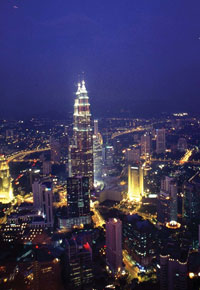
THE Far East offers a potent mix of diverse travel and tourism experiences and opportunities.
Although made up of geographically linked but culturally and ethnically separate countries, each country’s tourism infrastructure, development and appeal vary. However, as a region, increases in economic growth, disposable income and leisure time, political stability and aggressive tourism campaigns, among other factors, have fuelled significant growth in most areas. These have helped balance a few recent blows to Asian tourism which saw dramatic drops in visitor figures, including the SARS epidemic and last year’s tsunami.
Several Far Eastern countries have always been open to international visitors and strongly attuned to tourism. These include Singapore, a city/state whose appeal lies in a safe and clean mix of financial districts and tourism precincts. Long a hub of progress and development in the region, it’s very easy to get around Singapore and explore the historical and modern attractions covering Eastern and Western cultures serviced through a mix of different languages.
The warmth of the people of Thailand as well as the excellent food and range of attractions has made the country a magnet for visitors for decades. From its exotic architecture to respected cultural and religious centres to historic ruins to clean beaches and modern shopping precincts, there’s something for everyone here.
Many predictions ranging from doom and gloom to huge increases in various aspects of the island’s tourism were made about Hong Kong’s busy tourism in the lead up to China’s takeover of this small outpost of business and trade in the late 90s. Fortunately, Hong Kong has stayed much the same as before with an eclectic mix of Eastern tradition and brisk modern trade. Here you can watch a dragon dance along a festive street or climb a mountain in a cable tram to view land, harbour and sea. Visitors roam the markets, little stores and glitzy shopping centres for an almost overwhelming range of goods.
Malaysia acknowledges the importance of tourism as a benefit to the country but does not allow these demands to overtake internal priorities. It has kept its conservative outlook and proud heritage including a colourful amalgamation of the region’s major cultures (Malay, Chinese and Indian as well as other minor ethnic races), creating a country of tropical charm and quiet treasures.
The modern and the traditional sit well together, including traditional villages and city skylines, where the tallest building in the world, the Petronas Twin Towers, reaches skyward. Historic settlements have been well preserved especially along the Western coast with Malacca and Penang boasting interesting streets packed with temples, shops, mosques and markets.
The Philippines, for its part, is an archipelago of over 7,000 islands with beaches, volcanic mountains and a variety of natural attractions. The capital, Manila, offers well-preserved historical architecture, shopping and entertainment. Diving is a popular tourist attraction and eco-tourism is the buzz word in this country. There are many festivals celebrated by diverse ethnic groups and the Filipinos are never hesitant when it comes to singing and dancing (often around food flavoured with Chinese and Spanish influences).
During the last decade, several countries that previously discouraged tourists have either developed their tourism infrastructure and/or lifted travel restrictions contributing to a surge in the number of tourist arrivals. One of these is Vietnam, which among the fastest growing tourism destinations in the Far East. The country takes its potential seriously with an enthusiasm for growth that actively seeks investment in tourism projects. To assist favourable tourism and investment conditions, Vietnam is now constantly developing its infrastructure including building roads and power systems. Other needs that have been analysed recently are technical facilities and training of tourism human resources.
Luckily for Vietnam, it has a large range of tourist attractions and immense potential for development, including four World Heritage Sites and environmental, historical, cultural and natural resources. Festivals among the 54 ethnic groups are common and a sprinkling of resorts caters for visitors looking for a higher level of comfort. The weather can be challenging with the country following monsoon cycles but, with preparation, the hot and humid stormy periods can be avoided.
Neighbouring Laos is a country where the pace is much slower. It has struggled with poor environmental record including deforestation and mismanagement of water resources, making forests, wildlife habitat and water disappearing commodities. Not surprising then that things are not so positive on the tourism front.
Most of the country is mountainous with many Buddhist centres. However, Vientiane, the capital, with a relaxed ambience offers a refreshing change from the humdrum of many other Asian cities. Arts and crafts are the main attractions for shoppers and a goldmine for those on the lookout for the unique, antique and exotic. The Mekong River is the easiest way to explore the country and many people arrive on an organised tour as few locals speak foreign languages and public transport is not freely available. Health is precarious and medical facilities outside of the capital city are very basic. Still, it’s an exciting destination for those who want to ‘get away from it all’.
The least known tourism destination in the region, however, is Cambodia. However, visitors to the country are still unlocking the mysteries, history and adventures that Cambodia offers.
Among the most frequented places are the capital, Phnom Penh, with its palaces and temples, the Mekong River, which is the focus of a spectacular water festival in November, and Angor Wat, a famous complex of 9th century temples half-buried in lush jungle – a reminder of a rich and highly ornate history. The abundant natural resources of rainforests, rivers and wetlands have been a recent focus for eco-tourism development, which is still in its infancy. Cambodia is indeed another exciting frontier for tourists to explore largely because of its many natural and historical attractions.
All in all the Far East, true to its name, conjures up an exotic feast for travellers. Offering immense tourism potential, it is certainly the place to watch out for.
